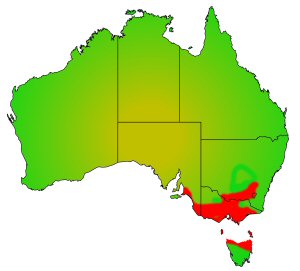Southern pygmy perch
|
Click to enlarge |
Scientific Name
Nannoperca australis
Other Common Names
None
Size
Commonly 65 mm, to 85 mm
Conservation Status
Common, widespread
Habitat
Often found in small systems with a low flow rate and quiet vegetated areas in streams, billabongs, lakes and even irrigation channels. Not usually found in open water, prefers covered habitats. Often seems to form loose aggregations.
 Distribution
Distribution
Victoria, south eastern South Australia, southern areas of the Murray-Darling basin in New South Wales. Fragmentation of habitat and population is becoming a major concern especially in the Murray-Darling system to the extent that recolonisation of areas where individual populations are lost is being hindered.
Reproduction
Spawns multiple times from September to January, when water temperatures are above 16°C During breeding males are territorial. Female produces between 100 and 1,000 transparent round and non-adhesive eggs which are scattered over plants or the substrate. When fully hydrated, fertilised eggs are 1.2.1.4 mm in diameter. Eggs hatch in 2 to 4 days producing larvae about 3 to 4 mm long.
Diet
Carnivorous, small crustaceans such as amphipods, ostracods and copepods, insects such as chionomid larvae, mayflies, mosquitos and other terrestrial insects. Juvenile fish tend towards planktonic crustaceans whereas adults tend toward terrestrial insects and other larger prey. Ideal fish to put in dams and ponds for mosquito control.
Angling
Not an angling species.
On the table
Not a food fish (for humans).
In the aquarium
An attractive aquarium fish which shows quite spectacular colours when in breeding condition. Should be kept in a well planted aquarium and will spawn in captivity. Best fed small live invertebrates.